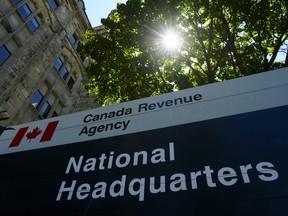
Article content
Overcontributions to tax-free savings accounts (TFSA) continue to be a big problem for thousands of Canadians, as well as a source of increasing tax revenue for the Canada Revenue Agency (CRA) as it relentlessly pursues the collection of penalty tax in the courts.
THIS CONTENT IS RESERVED FOR SUBSCRIBERS ONLY
Subscribe now to read the latest news in your city and across Canada.
- Exclusive articles from Barbara Shecter, Joe O'Connor, Gabriel Friedman, and others.
- Daily content from Financial Times, the world's leading global business publication.
- Unlimited online access to read articles from Financial Post, National Post and 15 news sites across Canada with one account.
- National Post ePaper, an electronic replica of the print edition to view on any device, share and comment on.
- Daily puzzles, including the New York Times Crossword.
SUBSCRIBE TO UNLOCK MORE ARTICLES
Subscribe now to read the latest news in your city and across Canada.
- Exclusive articles from Barbara Shecter, Joe O'Connor, Gabriel Friedman and others.
- Daily content from Financial Times, the world's leading global business publication.
- Unlimited online access to read articles from Financial Post, National Post and 15 news sites across Canada with one account.
- National Post ePaper, an electronic replica of the print edition to view on any device, share and comment on.
- Daily puzzles, including the New York Times Crossword.
REGISTER / SIGN IN TO UNLOCK MORE ARTICLES
Create an account or sign in to continue with your reading experience.
- Access articles from across Canada with one account.
- Share your thoughts and join the conversation in the comments.
- Enjoy additional articles per month.
- Get email updates from your favourite authors.
THIS ARTICLE IS FREE TO READ REGISTER TO UNLOCK.
Create an account or sign in to continue with your reading experience.
- Access articles from across Canada with one account
- Share your thoughts and join the conversation in the comments
- Enjoy additional articles per month
- Get email updates from your favourite authors
Sign In or Create an Account
or
Article content
As a reminder, if you accidentally overcontribute to your TFSA you will face the overcontribution penalty tax, which is equal to one per cent per month for each month you’re accidentally over the limit. You can request that the CRA waive or cancel the tax, which it has the power to do, if it can be established that the tax arose “as a consequence of a reasonable error” and the overcontribution is withdrawn from the TFSA “without delay.”
Article content
Article content
Article content
New data obtained by Investment Executive last month shows that the CRA assessed $166.2 million in TFSA overcontribution tax in 2024, up from $130.8 million in 2023. About 133,000 out of 19.3 million account holders were found to have overcontributed to their TFSA, with an average tax of $1,252 assessed per taxpayer. That compares with 117,000 overcontributors in 2023, with an average excess tax of $1,118.
Article content
By signing up you consent to receive the above newsletter from Postmedia Network Inc.
Article content
Part of the reason so many taxpayers seem to be overcontributing can be attributed to a lack of understanding of the TFSA contribution limit. While that information can be found online using the CRA My Account access, it may not be up to date and may exclude recent contributions and withdrawals. For example, financial institutions only send TFSA transaction information for a given calendar year at the end of February of the following year. So, if you check your TFSA room online in the first few months of the year, you’ll be missing any TFSA contributions or withdrawals from the previous year (plus anything you did in the current year).
Article content
To this end, and as part of the CRA’s 100-day Service Improvement Plan, the CRA recently announced that the agency has been working to improve and simplify its web pages to make taxpayers’ experience with TFSAs “smoother and more efficient.” Its general TFSA web pages have been updated and now feature improved information on what a TFSA is, how to open one, what to think about before you contribute and how to make a withdrawal. The site also provides clearer step-by-step instructions to calculate how much you have contributed and more detailed explanations of what to do if you accidentally overcontribute.
Article content
Article content
The revamped CRA TFSA information site also now provides clear examples that illustrate how to calculate out your contribution limit, and has instructions on how to use the TFSA calculator available in your CRA account, as well as how to complete the TFSA contribution room worksheet.
Article content
Article content
But another problem that still needs to be addressed in the context of TFSA overcontributions is how to remove excess contributions if the fair market value of the investments inside your TFSA has plummeted to such an extent that it is below the value of the overcontribution you need to withdraw. This was addressed in a case I wrote about over the summer, where a federal judge called this a “perpetual tax trap” for the unfortunate taxpayer, adding that it “appears to be inconsistent with (Parliament’s) intent.”
Article content
This issue arose yet again in another recent TFSA overcontribution case decided in September. The taxpayer was assessed taxes, interest and penalties for overcontributions to his TFSA. At the same time, he experienced losses exceeding 90 per cent in his TFSA investments.
Article content
Between 2014 and 2022, the taxpayer contributed a cumulative amount of $286,500 to a self-directed TFSA account. However, owing to a pattern of unsuccessful investments, by 2022 he had suffered losses of $269,518, leaving his account balance almost entirely depleted. His excess contributions subject to overcontribution tax during this period totaled about $205,000.

.jpg) 4 hours ago
1
4 hours ago
1
 English (US)
English (US)